
Caryophyllaceae, commonly called the pink family or carnation family, is a family of flowering plants. It is included in the dicotyledon order Caryophyllales in the APG III system, alongside 33 other families, including Amaranthaceae, Cactaceae, and Polygonaceae. It is a large family, with 81 genera and about 2,625 known species.
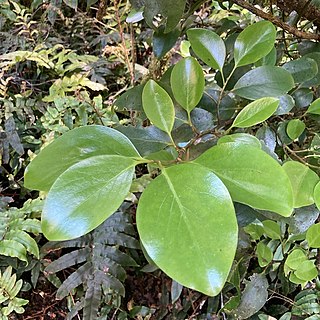
Griselinia littoralis, commonly known as kapuka, New Zealand broadleaf or pāpāuma, is a fast-growing small to medium-sized evergreen tree that is native to New Zealand.
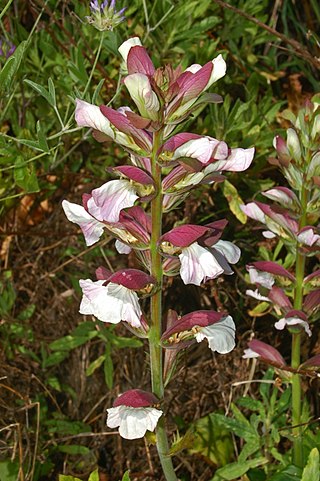
Acanthus mollis, commonly known as bear's breeches, sea dock, bear's foot plant, sea holly, gator plant or oyster plant, is a species of plant in the family Acanthaceae and is native to the Mediterranean region. It is a leafy, clump-forming perennial herb, with a rosette of relatively large, lobed or toothed leaves, and purplish and white flowers on an erect spike.
Amaranthus wrightii is a species of flowering plant. It goes by the common name of Wright's amaranth. It occurs from western Texas into southern Arizona and as far north as Colorado at elevations between 500–2,000 m (1,600–6,600 ft).

Quercus imbricaria, the shingle oak, is a deciduous tree in the red oak group of oaks. It is native primarily to the Midwestern and Upper South regions of North America.
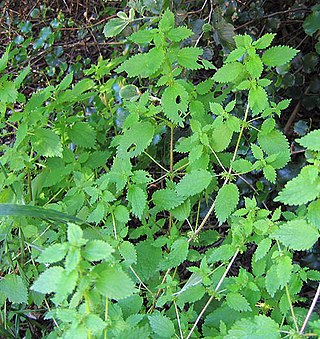
Hesperocnide tenella, also known as western nettle or western stingingnettle, is native to California and northern Baja California. It grows in chaparral, oak woodland, and coastal sage scrub communities up to 1,000 metres (3,300 ft) elevation.

Campanula latifolia, the giant bellflower, is a species of bellflower in the family Campanulaceae. It is also known as the large campanula and the wide-leaved bellflower. It is native to Europe and western Asia and is widely grown as an ornamental plant.
This page provides a glossary of plant morphology. Botanists and other biologists who study plant morphology use a number of different terms to classify and identify plant organs and parts that can be observed using no more than a handheld magnifying lens. This page provides help in understanding the numerous other pages describing plants by their various taxa. The accompanying page—Plant morphology—provides an overview of the science of the external form of plants. There is also an alphabetical list: Glossary of botanical terms. In contrast, this page deals with botanical terms in a systematic manner, with some illustrations, and organized by plant anatomy and function in plant physiology.
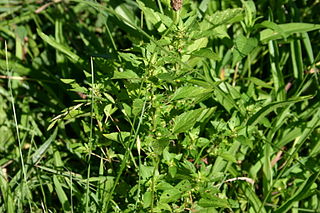
Acalypha rhomboidea is a plant in the spurge family, Euphorbiaceae.
Sclerosperma is a monoecious genus of flowering plant in the palm family found in Africa where three species are known. Having no obvious relatives, it does resemble the Madagascar native Marojejya though a detailed study of Madagascar's palms is required to determine if any true relationship exists. The lack of relatives, and its interesting qualities, indicate, at one time, the existence of a diverse African palm flora. The name is from two Greek words meaning "hard" and "seed".
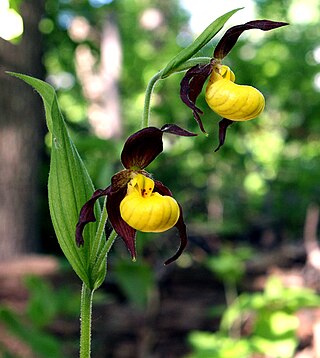
Cypripedium parviflorum, commonly known as yellow lady's slipper or moccasin flower, is a lady's slipper orchid native to North America. It is widespread, ranging from Alaska south to Arizona and Georgia. It grows in fens, wetlands, shorelines, and damp woodlands.

Calochortus amabilis is a species of the genus Calochortus in the family Liliaceae. It is also known by the common names Diogenes' lantern, yellow globe-tulip, golden globe-tulip, yellow globe lily, golden fairy lantern, golden lily-bell, Chinese lantern, and short lily.
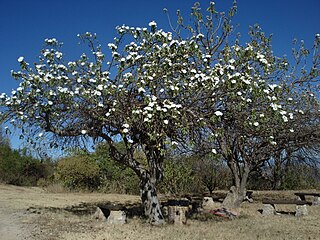
Ipomoea arborescens, the tree morning glory, is a rapidly-growing, semi-succulent flowering tree in the family Convolvulaceae. This tropical plant is mostly found in Mexico, and flowers in late autumn and winter. Its common name in Nahuatl is Cazahuatl or Cazahuate.

Acalypha gracilens is a species of flowering plant in the family Euphorbiaceae. Common names include slender threeseed mercury; three-seeded mercury; shortstalk copperleaf; slender copperleaf. It is native to the south-eastern United States.

Clematis hedysarifolia is a liana, endemic to peninsular India, belonging to the buttercup family (Ranunculaceae). It was described by Augustin Pyramus de Candolle and published in Regni Vegetabilis Systema Naturale 1: 148, in 1817.
Hypericum cuisinii is a perennial herb in the genus Hypericum, in the section Adenosepalum. The herb has pale yellow flowers and occurs in Greece and Turkey.

Aporosa octandra is a species of plant in the family Phyllanthaceae found from Queensland and New Guinea to Indonesia, Zhōngguó/China and India. It is a highly variable plant with 4 named varieties. Its wood is used in construction and to make implements, its fruit is edible. The Karbi people of Assam use the plant for dyeing, textile colours have quite some significance in their culture.

Itoa orientalis is a species of flowering plants belonging to the family Salicaceae. An evergreen tree from China and Vietnam, and cultivated as an ornamental tree.

Itoa is a genus of flowering plants in the family Salicaceae. It is also in the tribe Saliceae.

Jatropha moranii is a very rare subshrub in the genus Jatropha known commonly as Moran's lomboy. This species in the family Euphorbiaceae is endemic to a small area of Cabo San Lucas in Baja California Sur. It is characterized by a succulent stem and branches, along with a distinct woody caudex, and attractive white flowers.
















